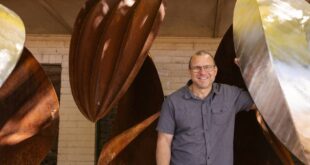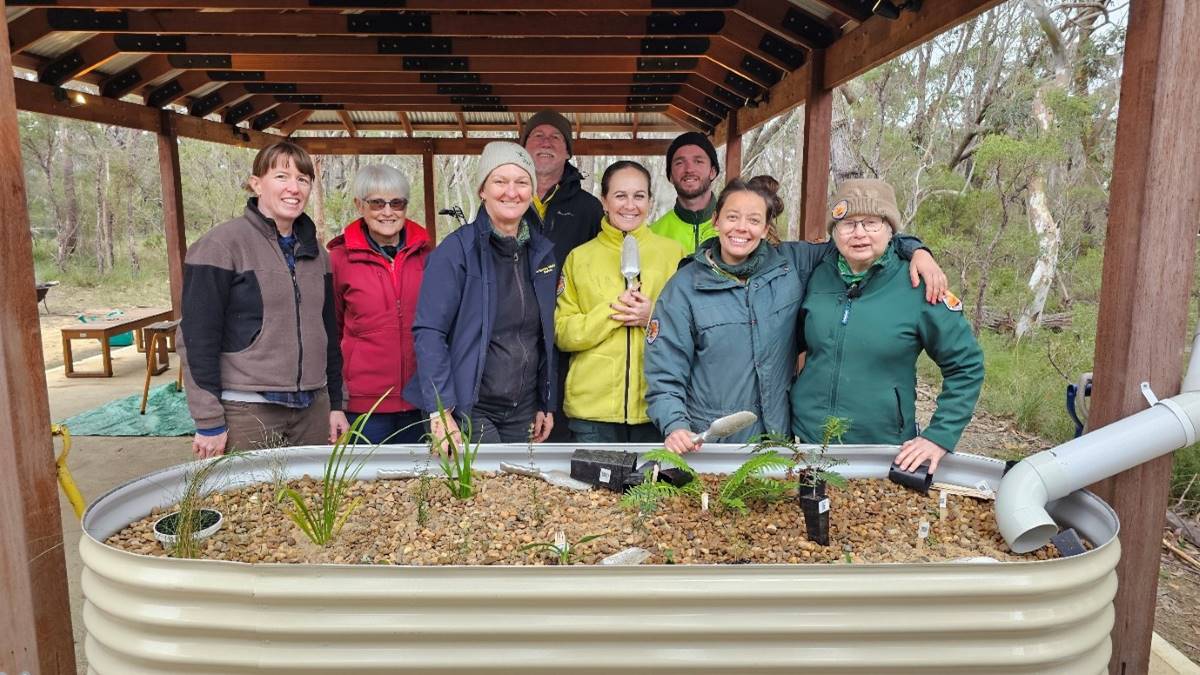
From left: Environmental Engineer Alexa McAuley from Civille, NPWS Bushcare volunteers Maree Giddens, Tracie McMahon and Rob Herbert, NPWS Field Officers Elissa McLaren, Eamonn Cunningham and Becky Chatfield, and Senior Field Officer Monica Nugent.
Story and photos by Hamish Dunlop
The National Parks and Wildlife Service in the Blue Mountains built a raingarden with the help of NPWS Bushcare volunteers. The garden filters water from the roof of the new shelter in Blackheath and slows runoff, limiting erosion. It reduces nutrient levels, disadvantaging introduced weeds. It’s a conversation starter too: what is a raingarden, and how does it work?
Key Points:
- Raingardens are effective tools for stormwater management. They filter pollutants, reduce erosion, and give a leg-up to native plants over weeds by reducing nitrogen and other nutrients that weeds prefer.
- Individuals and communities can build raingardens; they are relatively easy to construct and can be made from various materials.
- Building raingardens can bring communities together and can be used as an educational tool.
Monica Nugent is the Senior Field Officer, Bush Regeneration at NSW National Parks and Wildlife Service Upper Mountains Area. She oversees bush regeneration activities and manages local NPWS volunteer programs. She tells me the new shelter, built next to the Heritage Centre in Blackheath, is primarily used for the Discovery Ranger Program. It’s a space for groups such as volunteers to use too.
“I thought the shelter would be a great place to showcase a raingarden,” Monica says. We had some Commonwealth funding available which enabled us to engage environmental engineer Alexa McCauley from Civille. Raingardens are an effective way to help manage stormwater at a local level,” she says.
“They slow water down and filter out excess nutrients such as nitrogen and other pollutants that collect on rooves. Nutrient enriched conditions favour introduced species, enabling them to thrive while discouraging native plants. If we can slow down the amount of stormwater run-off, we can reduce weed spread into the Greater Blue Mountains World Heritage Area,” she explains. “This helps natives to either hold strong or recover more successfully while also reducing sedimentation and erosion of our waterways.”
Raingarden Construction Overview
Watch our 6-minute overview of raingarden construction:
How does a raingarden work?
Alexa is mostly involved with large stormwater management projects, but she thinks that building raingardens is something communities can do to support the environment. “Raingardens are made from graded sediments, with local natives planted on top. Water off the roof or other stormwater, is fed into the top of the garden. The plants and fine sand filter out a substantial amount of nutrients and pollutants. At the bottom of the garden, the filtered water enters a perforated pipe covered by gravel and flows out.”

A side view of the Blackheath shelter raingarden. (Courtesy of Civille)
“You can build small ones out of planter boxes – anything really – or make a pit in the ground,” Alexa says. Generally, you want a container that is waterproof, but you can build ones in the ground. In that case, the filtered water can naturally soak down.
For any kind of raingarden, piping can be purchased from any of the major hardware stores, Alexa continues: “A few hand tools are required, mostly to work with the piping. In the Blue Mountains, the gravel and sand needed can be purchased by the bag, or from landscape and building suppliers.”
Building a raingarden
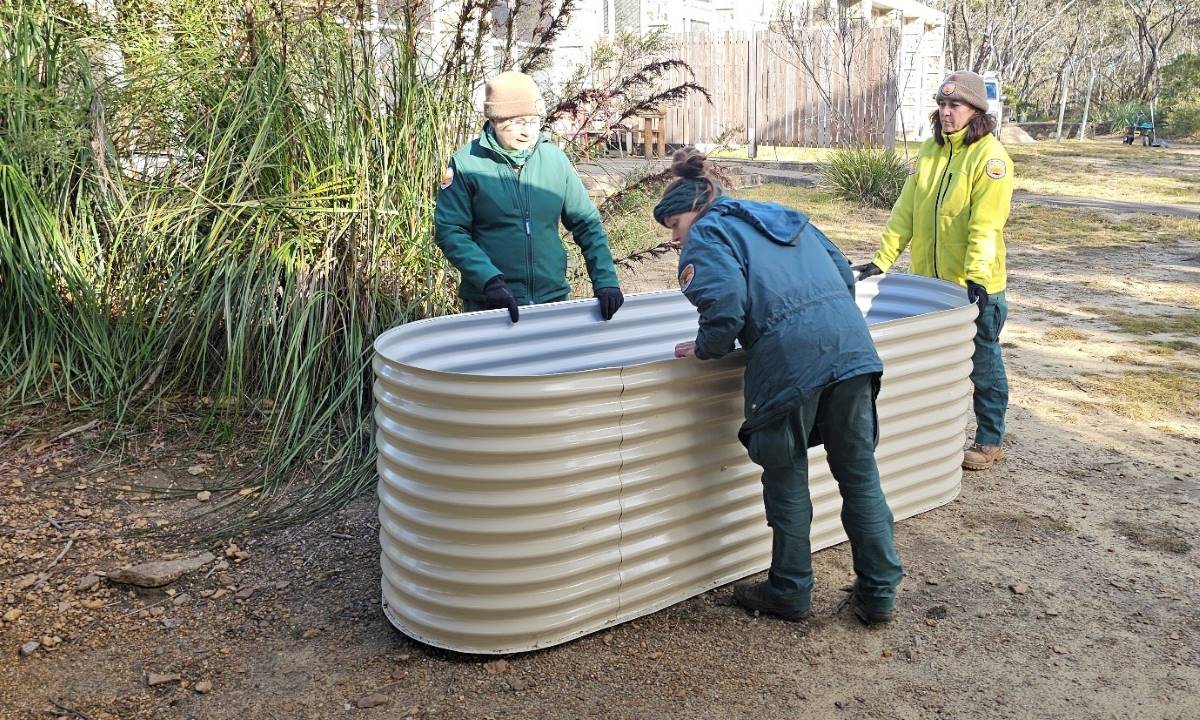
Monica, Becky and Elissa inspecting the sealed bed. The box is 0.8m deep, 0.8m wide and 2.4m long. Alexa says you don’t need to buy everything new. You could use an old, raised garden bed and seal it with silicone, or use some pool lining to make something else waterproof.
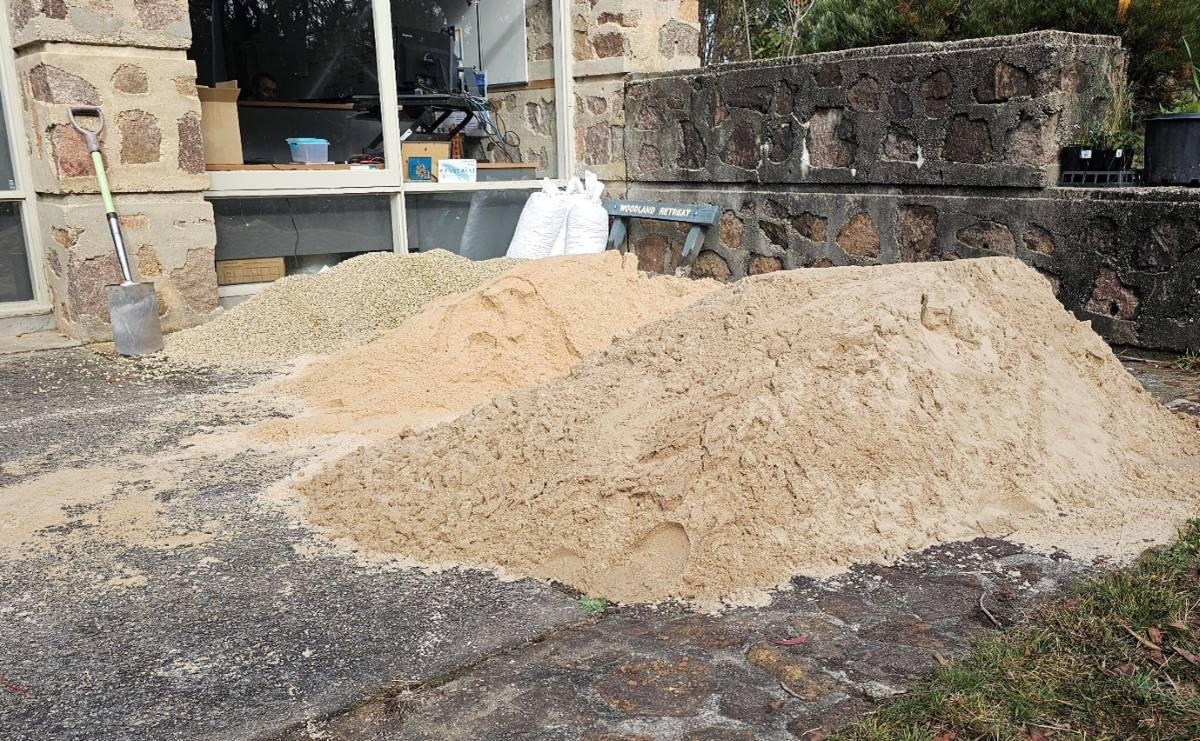
The three kinds of substrates: 10mm gravel (500kg), coarse sand (500kg) and fine sand (1000kg). There were also some bags of 20mm river stones for the top. Delivered, this cost $325 dollars.
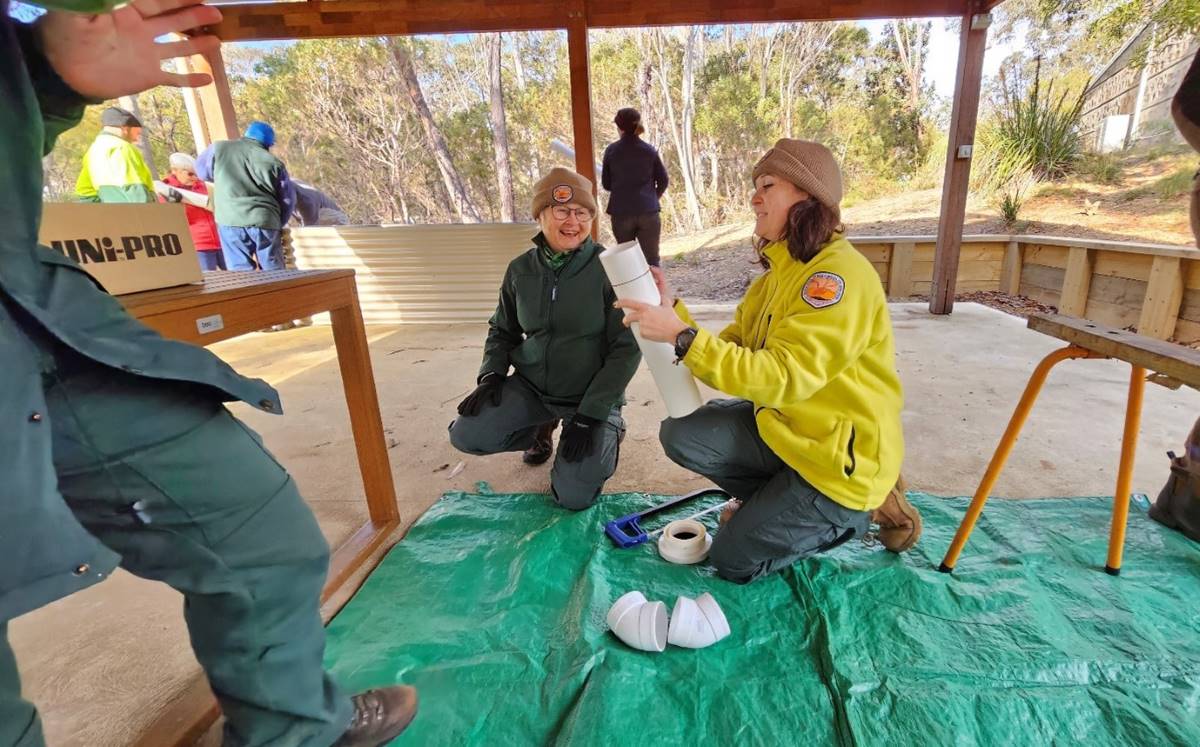
Monica and Elissa measuring twice before cutting once! The hacksaw is visible next to Elissa’s knee. The green tarp is down to catch the little bits of plastic that are created during the cutting. This stops them getting into the environment.
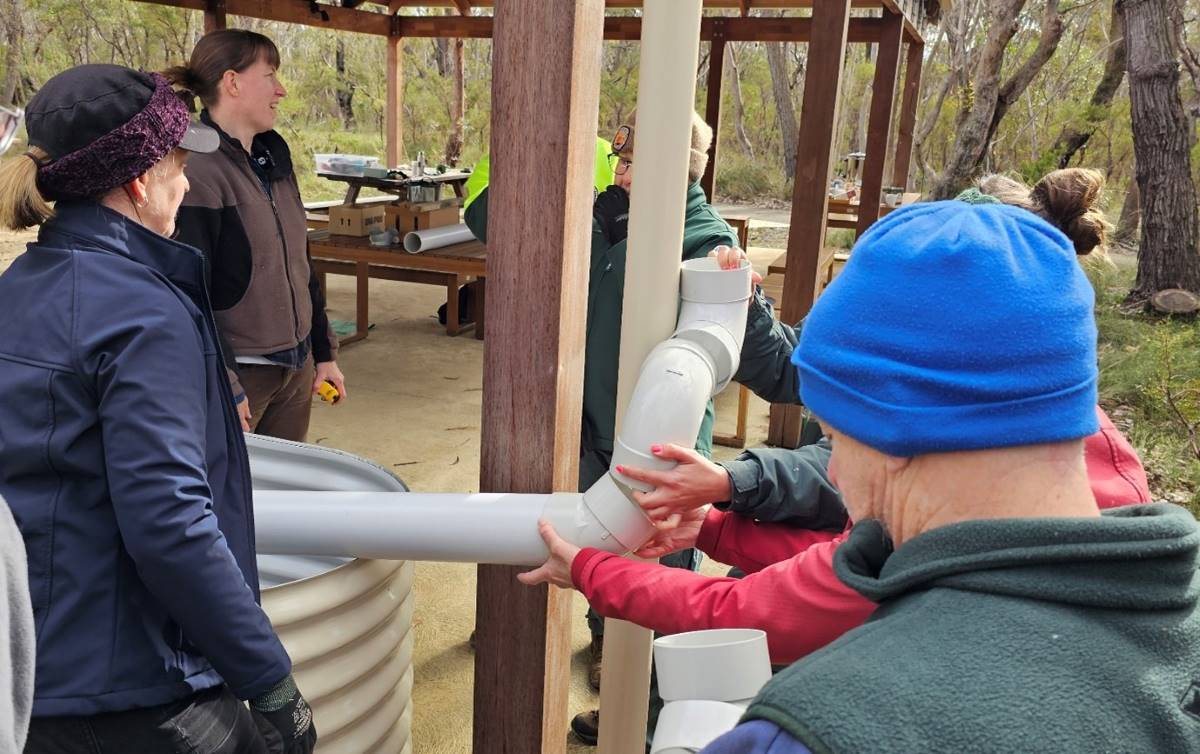
Many hands solving the pipe puzzle. The joined pipes that funnel water into the garden are being positioned, to establish where to cut the downpipe. The simple pipe bracket used to fix the joined pipe sections onto the corner post of the shelter is not shown.

Starting to fill the bed with the gravel. You can see the perforated pipe running from the bottom of the vertical overflow pipe with its grate, to the outlet at the far end. If too much water comes off the roof and can’t be absorbed, it will run into the overflow pipe and not spill over the sides of the garden. This makes sure the flow of water can always be predicted.
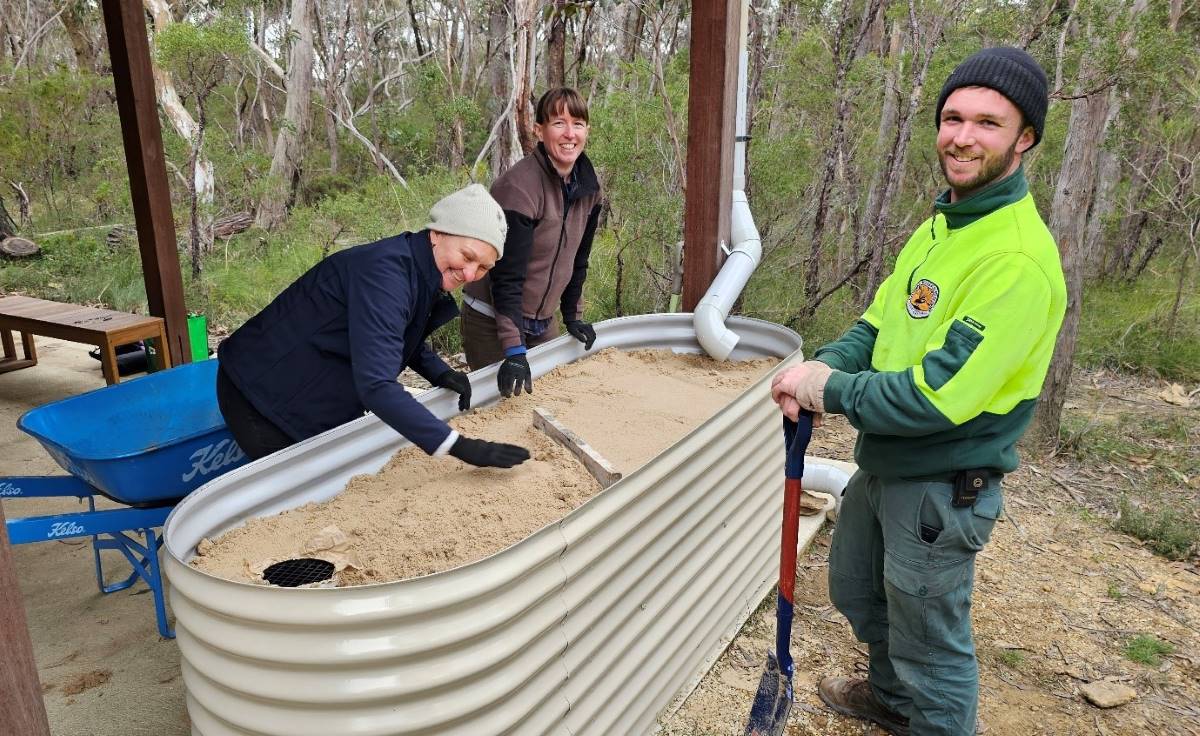
Look at our handywork! Tracie, Alexa and Eamonn at the final sand levelling stage. Note the overflow pipe grate sitting a few centimetres above the top of the sand.

Tracie, Keith, Monica, Becky and Alexa talking about the plants. A thin layer of river stones has been added on top of the sand and the plants are being positioned. Monica says they should be local to the area. Ones that can withstand both wet and dry conditions are best. She says many of our local natives are suitable as they are naturally adapted to well drained, sandy soils. Sedges, grasses, small shrubs and even some ferns are appropriate.
The plants chosen for this bed include: Fishbone Water Fern (Blechnum nudum), Wallaby grass (Rytidosperma), Poa sieberiana, Branching Grass-flag (Libertia paniculata), Ivy-leaved Violet (Violaceae hederacea), Flax lily (Dianella ), Laurel-leaf Grevillea (Grevillea laurifolia); Mint Bush (Prostanthera rotundifolia), River rose (Bauera rubiodes).
The shelter: ‘Come Friends, Listen’
One of Monica’s motivations for the rain garden workshop was to provide an upskilling opportunity for the volunteers and NPWS staff. It was also a way of recognising volunteers with a nice lunch, for the amazing work they do. “It’s great to be able to bring volunteers and NPWS staff together,” Monica says, “especially staff that don’t necessarily have much contact with volunteers. It strengthens relationships with the community and provides an educational opportunity.”
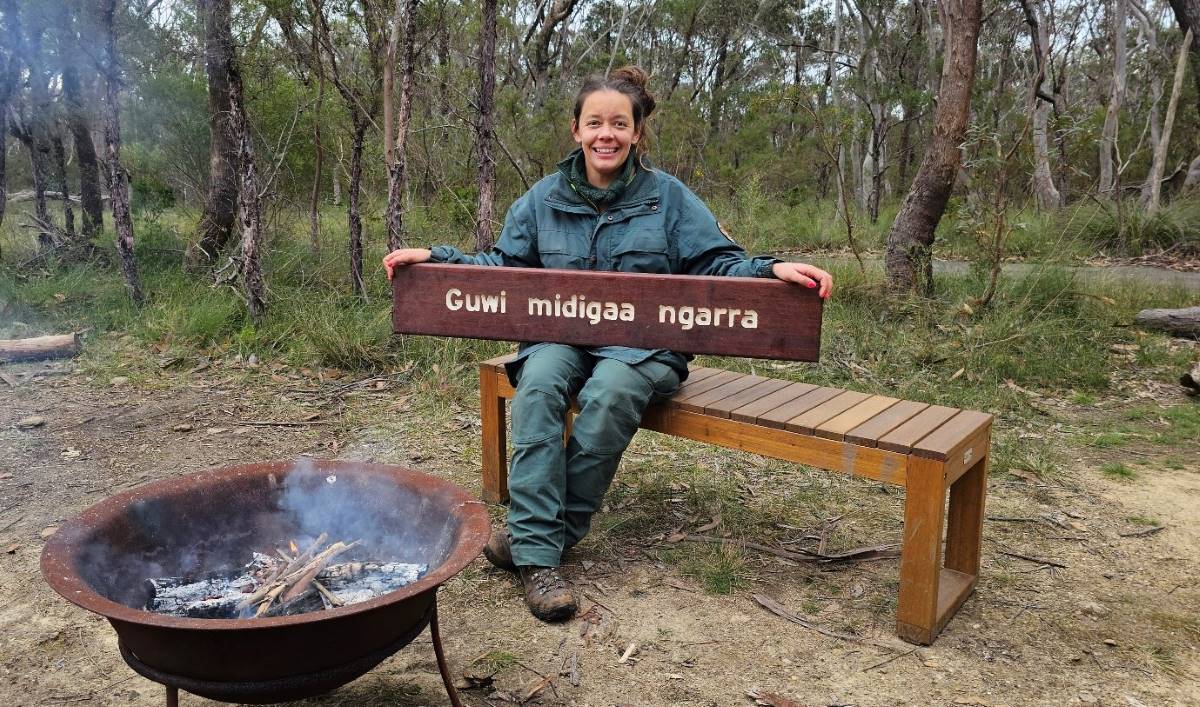
Becky Chatfield holding the name sign for the shelter
Becky Chatfield is a proud Kamillaroi woman and one of the NPWS staff at the raingarden workshop. She says the shelter where the raingarden has been built is a place where school children and others can come to learn about the environment and culture. “The shelter is on Dharug and Gundungurra Country,” she says. “It’s really fitting that it has an Aboriginal name, one that can inspire everyone.”
“Guwi midigaa ngarra means, ‘Come friends, listen’,” Becky explains. “It’s wonderful to be able to welcome people to listen to stories and learn.” Darug/Darkinjung woman Cindy Laws at NPWS proposed the name and Dharug women Aunty Corina Norman provided advice on the spelling and pronunciation. Becky and Field Officer Elissa McLaren created the sign in the NPWS work shed.
Volunteers’ Voices
Tracie McMahon was one of the NPWS Bushcare volunteers at the workshop. Rather than thinking about volunteering as a transactional exchange, she thinks about it as relational practice. “I started volunteering after the 2019/20 fires. While I was healing on Country, Country was healing alongside me. You’re out there with amazing people too, who know so much. You get to learn from them and spend time together. It’s an incredible opportunity.”
The power of collective and sustained action is something Tracie sees time and time again. “I find pulling out weeds meditative,” she says. In some ways, it seems like a small thing to be doing in a vast wilderness. But after a few hours, you’ve made a substantial pile of weed seedlings. What you also know is that you’ve stopped those thumb-sized plants growing to metres in height and spreading seeds.
Maree is another volunteer at the workshop. While we’re talking, everyone is busy around us. There’s an overflow of goodwill and a healthy dose of laughter. Like Tracie, she values the people interactions – she’s made some great friends.
There’s something else though, which comes to the surface. It’s about value, she concludes, but not specially for her, or us as a species. “I just love seeing the bush healthy,” she reflects. “Watching and learning is part of it, and we are part of it, but not in a way where it belongs to us.”
Take Action:
Share this article:
This story has been produced as part of a Bioregional Collaboration for Planetary Health and is supported by the Disaster Risk Reduction Fund (DRRF). The DRRF is jointly funded by the Australian and New South Wales governments.
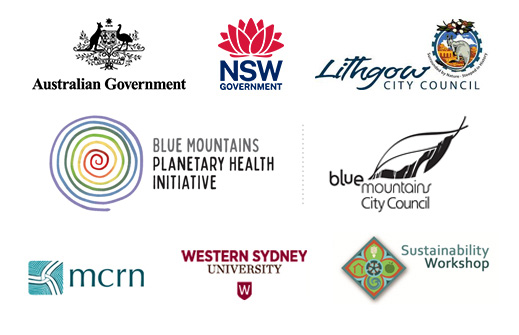
More from around the region
A huge thank you to Josh Logan from Logan Signs, Lithgow, for installing our Circular Water Signage in time for our World Animal Day Celebration today at the Blue Mountains Planetary Health Centre (33-39 Acacia St Katoomba). We have a full program of events with lots of information on how to prepare for the summer ahead and how to create urban areas that help us share our home respectfully with all species. It will be a fun family day too with storytime, craft and live music for kids! (Link in profile) #worldanimalday #planetaryhealth #familyday #katoomba #bluemountains
And our Wild Life exhibition is now up for World Animal Day tomorrow at the Blue Mountains Planetary Health Centre. Photographs by Warren Hinder, Merryl Watkins, Holly Kent and Tracy Burgess. Check out all the other events from stalls, talks, possum box demo, kid`s craft and animal storytime, plant based food and live music to Bushcare. @33-39 Acacia St Katoomba Link in profile. #planetaryhealth #worldanimalday #katoomba
Join the Blue Mountains Planetary Health Initiative at World Animal Day this Saturday 5 October for a discussion on the history of the Plant Based Food Movement in Australia and a discussion of exciting contemporary trends. It will be followed by a Plant Based Cheese Degustation to launch the Plant Inspired Community Cooking Project. This will be a series of cooking classes to introduce the community to plant based cooking techniques. The event is free but places are limited so bookings essential (link in profile): https://bit.ly/3Bzbwhu
#plantbasedcooking #worldanimalday #bluemountains #katoomba #planetaryhealth #communitycooking
We share the Blue Mountains with so many extraordinary beings but have you seen them and do you know their names? Do you know the difference between a Royal Spoonbill and an Eastern Shrike-tit, or the difference between a bandicoot and an antechinus? Come and check out our Wild Life Exhibition at World Animal Day this Saturday to learn more from the stunning photographs by Warren Hinder, Merryl Watkins, Holly Kent and Tracy Burgess. There will be also be a Breakfast with the Birds at 8.30am, Animal Storytime and Craft for kids from 10am, stalls, talks, food and live music. The day is free but please book via Eventbrite to help us cater (link in profile): https://bit.ly/4eMhbz0 @bluemountainswalks @merrylwatkinsphotography @bestofbluemountains
#royalspoonbill #easternshriketit #wildlife #birdsofthebluemountains #bluemountains #katoomba #worldanimalday #biodiversity #planetaryhealth
To coincide with the first day of Bushfire Season we launched Air Watch at the Planetary Health Centre yesterday. For the last seven years Blue Mountains Unions & Community have been working tirelessly to ensure residents of the Blue Mountains and Lithgow are able to measure and track the quality of the air we breathe. The Blue Mountains Planetary Health Initiative has worked closely with them over the last year and now there are 20 PurpleAir monitors distributed throughout the Blue Mountains and Lithgow, including one at the Planetary Health Centre. You can now view real time air quality measurements at each of our local news sites and on the Purple Air Map https://map.purpleair.com We have 10 more sensors available, so if you’d like to install a sensor, members of BMUC will be at World Animal Day at the Planetary Health Centre this Saturday 5 October to take applications and share more information about the project. Bookings for World Animal Day here (link in profile): https://www.eventbrite.com.au/e/world-animal-day-promoting-respectful-cohabitation-tickets-1029328889417
It was a fabulous day yesterday as each speaker highlighted how critically important this project is: Dr Rosemary Dillon CEO of Blue Mountains City Council Trish Doyle MP Dr Jenna Condie from Blue Mountains Parents for Climate Dr Maggie Davidson, environmental scientist from Western Sydney University Matthew Riley, Director Climate and Atmospheric Science from NSW Department of Climate Change, Energy, the Environment and Water and Peter Lammiman and Ann-Maree McEwan from the BMUC’s Airwatch Committee.
@bluemountainsunionists @nswdcceew @bluemountainscitycouncil @westernsydneyu @trishdoylemp @parentsforclimatebluemountains #airqualilty #airqualitymonitors #bluemountains #planetaryhealth
Treat yourself this weekend with a fun-filled and informative World Animal Day event at the Planetary Health Precinct in Katoomba. As well as a Breakfast with the Birds, stalls and a possum box demonstration, there will be a fabulous wildlife exhibition with photos by Warren Hinder, Merryl Watkins, Tracy Burgess and Holly Jayne; live music with Mem Davis, Joe Flood and Duck Keegan; lots of fun for kids with Sharon Baldwin and Naomi Crew leading animal storytime and craft with Julie Refferty; delicious plant based, gluten and dairy free treats, pastries and donuts from Clean Cravings; a plant based cheese degustation and warming Dahl, rice roasted cauliflower with veggies, pakoras, tamarind chutney, and salad courtesy of Bibi’s Kitchen. Come and learn more about Blue Mountains Bird Observers, Blue Mountains Conservation Society, WIRES, Action for Animals Blue Mountains and Animal Sanctuaries, Wombat Rescue, the Women’s Shed, and Animal Welfare Laws in Australia.
Guest speakers throughout the day will include Elizabeth Ellis, lecturer and author of Australian Animal Law; Hal Ginges, a local lawyer and animal activist from Action for Animals who advocates for animal rights and raises money for sanctuaries; Mark Berriman who has been President of the Australian Vegetarian Society NSW since 1989, as well as Co-ordinator for Animal Liberation NSW, Director of the Natural Health Society of Australia and the World League for Protection of Animals; and Teya Brooks Pribac, a researcher in the area of animal studies and the award-winning author of Enter the Animal. She’s also published Not Just Another Vegan Cookbook and will be sharing her culinary skills with the community in the Plant Inspired Community Cooking Project.
The event is free but please book your place to help us cater (link in profile): https://www.eventbrite.com.au/e/world-animal-day-promoting-respectful-cohabitation-tickets-1029328889417
#worldanimalday #plantbased #planetaryhealth #katoomba #bluemountains
We are so looking forward to kicking off World Animal Day Celebrations on Saturday 5 October with an 8.30am Breakfast with the Birds. Join Paul Nagle from the Blue Mountains Bird Observers on a guided bird walk around the Planetary Health Precinct visiting different habitats on the site to observe and talk about the birdlife that is resident and that visits the site. Binoculars are highly recommended.
World Animal Day will be an inspiring family day celebrating the extraordinary diversity of animals we share our world with! The theme is `Promoting Respectful Cohabitation`. Bookings for the Breakfast with the Birds (link in profile)
or here:
https://www.eventbrite.com.au/e/breakfast-with-the-birds-tickets-1028664983657
#birdlife #breakfastwiththebirds #katoomba #worldanimalday #bluemountains #planetaryhealth #respectfulcohabitation
We all need clean air to breathe, but how can we tell how clean our air is?
Thankfully the Air Watch subcommittee of Blue Mountains Unions & Community has worked for years to find ways to help us measure the quality of the air we breathe. Over the past year the Blue Mountains Planetary Health Initiative has worked with them to install Purple Air Quality monitors across our bioregion from Lithgow to the Lower Mountains. You can now view real time air quality on each of our Local News Sites!
Air Watch`s Purple Air quality monitors give the Blue Mountains` 78,000 residents, workers and 3 to 5 million/year visitors the power to make timely, informed decisions about their activities and health. It will also be a reliable source of data for the scientific community.
To coincide with the start of the Bushfire Season on Tuesday 1 October, we`re inviting the whole community to join us to launch Air Watch Blue Mountains and Lithgow at the Planetary Health Precinct. If you`d like to join us book a place here https://bit.ly/4dp2qko (link in profile)
#airquality #purpleair #bluemountainsunionscouncil #planetaryhealth #bluemountains #katoomba #bushfireseason
Today`s the day for the Blue Mountains Sustainability Festival! @bluemtns_sustainability_fest
We`ll be at the Speakers Forum at the Blue Mountains Cultural Centre at 10.15, talking about volunteer opportunities with the Blue Mountains Planetary Health Initiative, and then giving a presentation at 2.30pm. There`s a jam-packed speakers program, community stalls and workshops, and a Shopping Trail through Katoomba and Leura. You can find more information on the website at https://resilientbluemountains.org/sustainability-festival/
#sustainability #slowfashion #slowshopping #fashiontrail #circulareconomy #planetaryhealth #community #katoomba
Our newsletter is out! Read about the Blue Mountains Sustainability Festival this Saturday, the Air Watch Launch next Tuesday and the upcoming World Animal Day: Promoting Respectful Cohabitation Event at the Planetary Health Precinct on 5 October. And check out the comprehensive Springwood & Lower Mountains Repairers Guide (link in profile): https://bit.ly/3TJiKFR
You can subscribe to receive this newsletter via any of our local news sites.
#sustainability #biodiversity #worldanimalday #airwatch #airqualitymonitors #sustainablefashion #circulareconomy #planetaryhealth





